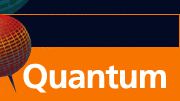 |

Tutorial
A Quick Introduction to Quantum Information
Quantum information is an exciting new paradigm for information science which makes use of the counterintuitive concept of quantum superpositions of information. This new concept raises the possibility of capabilities for information transmission, storage, and manipulation that are simply impossible with conventional information technologies. In the past few years there have been advances in the experimental study of the foundations of quantum mechanics, photonics, and atomic physics that have made accessible these novel uses of quantum states.
Revolution in Computer Science
Moreover, important applications of quantum mechanical concepts to
information security and information assurance have been identified, and so
this field has recently undergone a dramatic revolution from an essentially
academic subject to one with an enormous potential to revolutionize computer
science. The realization of these new information science concepts requires
the ability to "engineer" quantum mechanical (coherent) states of several particles which have hitherto only been used in quite limited forms for testing the foundations of quantum mechanics.
Foundations of Information Science
The foundations of information science were laid out during and shortly after
World War II and tacitly assumed that information, whether in the form of ink
on paper or voltages in a microprocessor, would be represented by processes
obeying classical physics. However, in the early 1980s Richard Feynman and
Charles Bennett (among others) began to investigate the generalization to information
represented by quantum physical processes. That is, they considered the representation
of binary numbers by orthogonal quantum states (|0> or |1>) of some suitable
two-level quantum system. (The representation of a single bit of information
in this form has come to be known as a "qubit.")
Examples of Qubit Representation in Systems
Examples of physical systems that permit such a qubit representation are ubiquitous: vertical
and horizontal photon polarization states ; single-photon interference states
in which a photon can emerge from one or the other exit ports of a Mach-Zehnder
interferometer; and the electronic ground and first (metastable) excited
state of a (trapped) ion, to list only three.
New Methods for Information Storage, Transmission, and Manipulation
From this pioneering work it
has been shown that quantum mechanics opens up powerful new methods for information
storage, transmission and manipulation because of the superposition principle,
the indivisibility of quanta and the peculiarities of measurement in quantum
mechanics.
 |

Table of Contents
|